What is a compost pit and how to equip it?
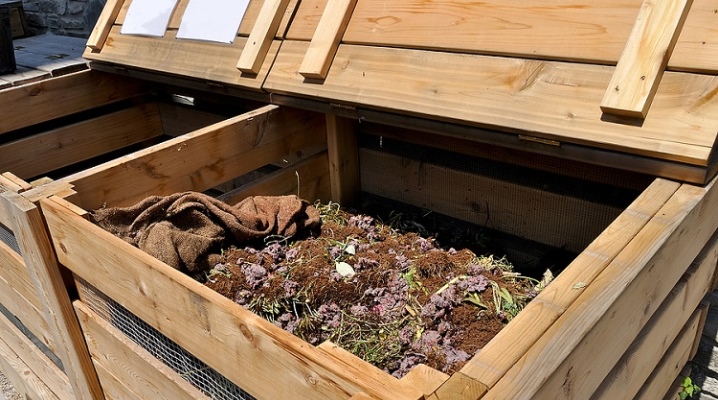
Experienced gardeners consider compost to be their faithful assistant in the care of crops and soil. It improves the quality of the soil, is a good fertilizer and base for mulching. Compost can be prepared without difficulty and at special costs - the main thing is to know where to place the compost pit, how to fill and equip it. Let's consider all these points in detail.
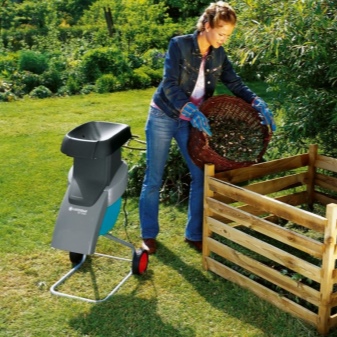
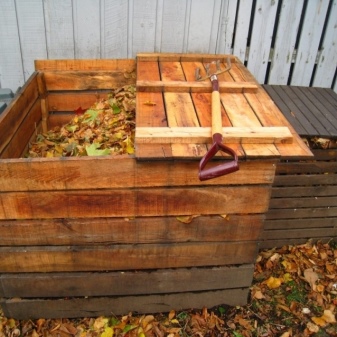
What it is?
Compost is primarily an environmentally friendly material (organic fertilizer) that improves soil properties and nourishes the plant with useful elements. The compost mass is made from organic waste, the decomposition process turns them into a useful composition. But they do not put completely rotten waste in the compost, so as not to provoke a bad smell. Mature compost smells like fresh forest soil, the fertilizer is uniform, dark (brown) in color. A solution for dressing is made from it or used in its natural form.
In the first case, one shovel of compost is dissolved in 20 liters of water, infused for a week, then garden and indoor plants are watered. In the second, the mass is introduced into the soil, while working with a rake: 5 kilograms of such fertilizer are designed for 1 square meter of land. The method of using compost as fertilizer is very common among gardeners. Almost all crops are fertilized with it. True, it is necessary to very carefully feed root crops, tomatoes, watermelons and melons, since they will “process” the compost to build up green mass, and the harvest will suffer.
And here cucumbers, zucchini, pumpkin and strawberries are especially fond of such food. "Saturated", they will give excellent fruits, saturated with a good aroma, with a pronounced taste. The compost is used to mulch the soil around the trees, and also to heat it in greenhouses and greenhouses. It is not difficult to equip a compost pit, and the benefits are multiple. There are many ways of making this special pit, it is desirable that it consists of 3 parts. The compost needs to be put in a "storage" for ripening. Openings for air exchange and ventilation must be left in the partitions.
The presence of a door or a removable cover is a prerequisite: during the ripening period of the waste mass, you need to have access to it in order to periodically stir the composition.
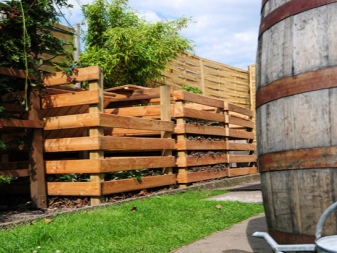
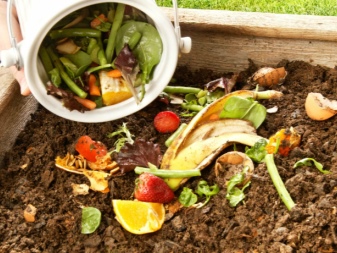
General device and dimensions
The classic version of a compost pit is a construction of 2x1.5 meters, also 1.5 meters high and 0.5 meters deep into the ground. However, experienced gardeners have their own calculations. They proceed from the fact that the compost organic matter should have a humidity of 55%, the temperature in the center of the composter should be at least 70-80 degrees, and conditions for good air circulation. And this can be achieved only with a volume of 1 cubic meter - which means that the dimensions of the composter should be 1x1 m and 1 meter high. If the volume is larger, it will be difficult to maintain the desired temperature, and if it is less, it will be difficult to maintain the desired humidity.
Constructions are made of closed and open types. A closed pit is considered more difficult. The frame for it is made either of wood or of concrete. If a wooden base is chosen, then before that the tree undergoes special processing so that it does not rot.To create an open compost heap, you need to dig a hole to a shallow depth, cover the walls with slate and put foliage, grass and organic matter there. As a rule, the front wall is made either removable or retractable - this way it is easier to pick up the mass for processing the beds. Well, you also need to have access in order to fill up the components, if the pit is not initially filled all at once.
Access to the contents must also be because the compost will have to be stirred periodically. The bottom is not covered with anything to leave the possibility of penetration of worms and microorganisms to the compost - they will help the waste ferment faster.
To prevent the spread of odor, it is necessary to cover such a hole with a tarpaulin, and you also need to protect the structure from precipitation.
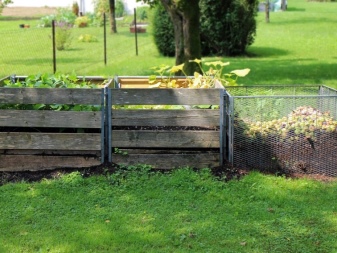
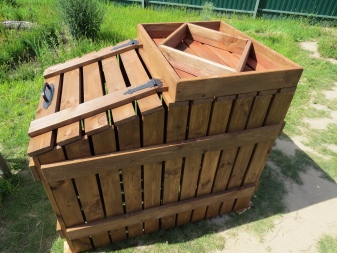
Where to locate?
Gardeners in the village usually arrange compost pits on their backyard plots: in the garden, vegetable gardens, not far from the house, in the backyard. If there are public composters nearby, a common area can be used. You can put organic matter on compost directly on the beds where crops are planted, but, as a rule, special pit structures are made. According to SNiP requirements, the location of the composter should be no closer than 8-10 meters from residential premises, the minimum distance from basements should be at least 7 meters, and also no closer than 25 meters from water sources.
The pile should be located away from the neighbors' fence - in order not to cause discomfort to them due to unpleasant air, it is necessary to observe the placement standards. When choosing a place for a compost pit, it is necessary to study the direction of the wind, this is especially important if the site is located within the city. And if you have found a suitable place, it is better that it be in the shade - the organic fertilizer will mature longer under the open sun.
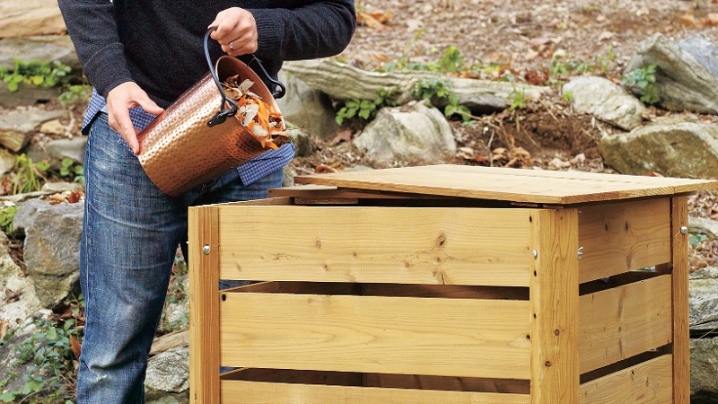
How to equip a pit?
Making a compost pit in the country with your own hands is not difficult. You can build it yourself from any available material: slate, corrugated board, wooden pallets, iron or plastic barrels, and more. There are factory collapsible structures, but you can make them permanent from concrete or bricks - such structures are considered more durable. Next, we will consider step-by-step instructions for making various options.
Finnish technology
Finnish composting technology is based on the continuous production of high-quality substrate. You can buy ready-made compartments for storing organic matter or make it yourself. The essence of the method is as follows: the boxes are filled sequentially, and then, taking out the finished fertilizer from the first compartment, the semi-finished compost from the second compartment is transferred into it, the contents of the third compartment are transferred to the second, which, after emptying, is filled again with waste, and so on.
Usually, to obtain a mature fertilizer from organic waste, it takes at least 2 years, and with this technology, the process is significantly reduced. If all standards for temperature and humidity are observed, a high-quality substrate can be obtained already 4 weeks after laying the biomass. Finnish composters should have a volume of 1 cubic meter. They need to maintain the moisture content of the content within 60% at a temperature of at least 70 degrees (up to 80 degrees is possible). Purchased devices have built-in sensors for measuring temperature and humidity.
For making it yourself, it is better to use wooden boards, having previously treated them with a special solution so that they themselves do not rot during the process of decay of organic substances. One of the cheapest and most convenient options is a compost pit using Finnish technology from pallets. Do not forget to correctly apply the dimensions for such a composter: 1x1x1 m.
This is a very important point, because in a smaller box, organic matter can dry out and turn into dust, and in a larger one, it can simply burn out from excessive heat.

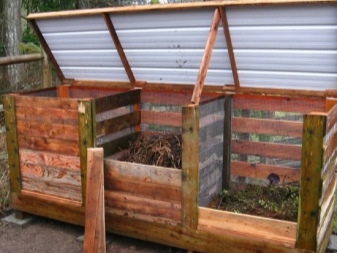
Slate
The slate pit will serve for a long time, and it can be done quite simply by burying the slate sheets in the ground along the perimeter. For a more capital structure, the laid wooden frame must be upholstered with slate. It all depends on whether you need a permanent compost pit or a temporary one. The structure can also be supported by metal pipes, but if it has wooden supports, then they must be periodically strengthened, treated with an antiseptic, or they must be completely replaced, which will require great effort.
The cover of such a device can also be made of wood, which also needs to be processed for a longer service. Using the same slate, the container is divided into two or three parts. There are those who consider slate not a very good material for making a device in which compost matures. In their opinion, organics in a slate structure will mature much longer, and therefore this is not the best option for the basis of a compost pit.
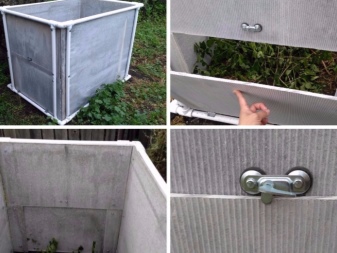
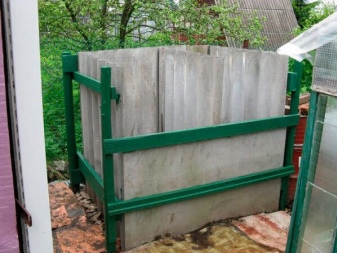
From pallets
You can make a compost pit from anything, but, according to most, a tree is still considered the ideal basis for this. And in order to quickly and without much waste build a compost bin, you can use pallets. They are affordable and do not need to spend on more expensive boards and bars. You just need to immediately purchase a special means to protect wood from the effects of soil and organics, as well as paint to improve the appearance of the structure. You need to paint the box at the end of the assembly, but the treatment with an antiseptic is done at the very beginning (follow the instructions). A compost pit is collected after the wood has completely dried: you can complete each 1x1 m wall separately, and then assemble everything by screwing pallet boards to the beams with screws.
On the front wall, you need to make a door at least 30 centimeters high, attaching it with hinges. Do not forget about partitions - there should be several of them. When the structure is assembled, a flooring of slabs should be made to the bottom, and for the excess liquid to drain off, it is necessary to leave gaps between them. In the summer, in the heat, you will need to water the contents of the box - the gaps between the slabs will fulfill their function.
It is better to make a gable roof, so that one slope is deaf, and the second is on hinges. This will allow you to freely load raw materials (waste and other organic matter) for conversion into fertilizer.
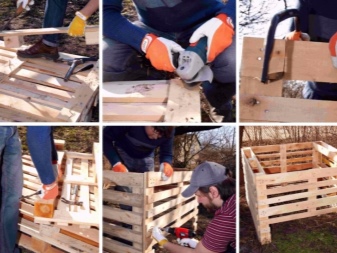

Brick
A compost pit can be created from ordinary red brick, white silicate or fireclay brick. The structure is driven out into three walls, small gaps are left in the masonry for air flow. By the way, bricks do not have to be bonded with cement mortar.
Such a structure can then be easily disassembled and moved to another site. It is imperative to provide an additional compartment for throwing and turning the contents in such a pit. You need to make the roof from a suitable material, preferably with a comfortable handle.
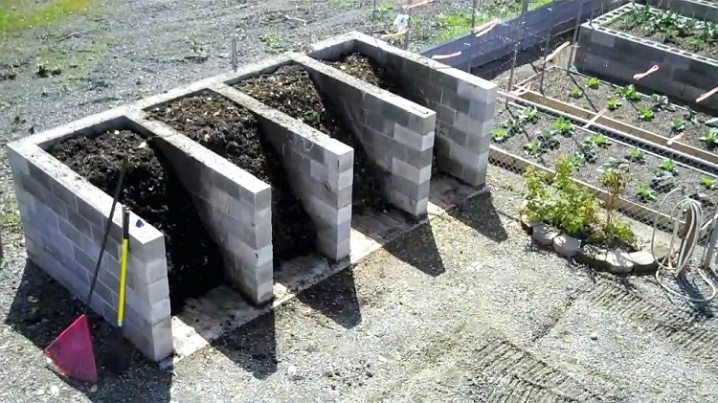
Other options
A strong, reliable and durable pit for organic decay is made of concrete rings. Such a well can be slightly dug into the ground or simply placed on the ground. You can put grass, even feces, dry foliage into it - high-quality compost will come out at no extra cost. Such a hole can be covered with foil, or a lid made of wood. The only drawback of this design is that it is inconvenient to get the finished fertilizer out of it. In a concrete base, it is not possible to make a door or a removable panel.
Anyone who has old iron drums or other metal structures can "ferment" the waste in them. You just have to cut out the bottom on both sides, then set the bases on a flat ground surface. Such containers are treated with black paint for better penetration of the sun's rays and maintaining optimal conditions in the composter. The only inconvenience is that you need to lift the barrel with a crowbar to get the finished fertilizer.
A much lighter device is obtained from car tires. You only need 4-6 tires to form a cylinder-pit out of them, and for the air to circulate, plastic tubes are passed through the rubber. Compost pits come in ready-made form, they just need to be installed and learned to use them. A dry closet is a special type of compost pit. This factory device is capable of processing even human waste into fertilizer. It has a compartment for a mixture of peat and sawdust. After visiting such a toilet, a person simply turns a special handle, as a result of which the waste is evenly covered with a wood-peat composition.
Such a composter will also accept small portions of food waste, which will also be covered with a special composition and "ferment", turning into organic food for plants and soil. As soon as one drawer of the dry closet is full, it is removed and another is inserted. The compost obtained in this way has a high concentration, therefore, when used, it is mixed with earth, a sand mixture or additionally bred with peat.
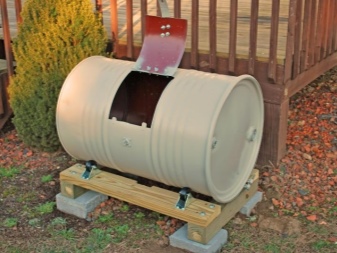
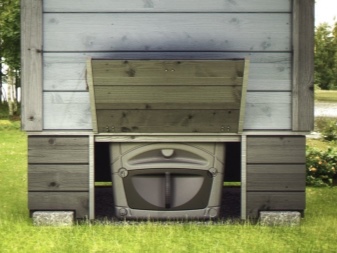
How and with what to fill?
Food waste is laid in layers, alternating, for example, potato peelings with foliage, then you can throw apples collected in the autumn in the front garden and cover them with tops. For composting, they choose raw peelings of berries, fruits, vegetables in their raw form, but, for example, potato skins and tomato waste should not be more than 20% of the total compost mass. You can add tea and coffee leftovers, onion skins, eggshells, other food waste, as well as straw, fresh grass, ash.
To make the finished composition more saturated, the components are mixed with manure or chicken droppings. In the absence of such, the compost must be filled with a small amount of saltpeter. It is not recommended to add weeds to the total mass. They make separate heaps of them, cover them with a film, and they rot separately - this is a guarantee that the weed will not take root again on the site. But the twigs, roots of conifers and ordinary trees are finely chopped and added for processing into a useful top dressing.

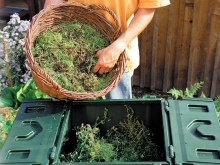
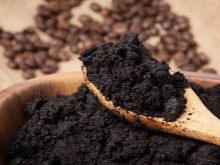
What is not allowed?
It is forbidden to put "diseased" vegetation in the compost affected by powdery mildew, late blight, various pests, and so on. Throw away or bury your pets excrement separately - this material is unsuitable for composting, primarily due to the possible presence of worms and parasite eggs in them. If this is not a special device for compost, such as a dry closet, then human feces should not be thrown into an ordinary pit. It is also not recommended to fill compost pits with cabbage waste: when rotting, this culture gives a strong unpleasant odor.
It is not recommended to throw meat waste and bones into the compost - this can attract rodents, as well as provoke a bad smell from the compost bin. Anything that does not decompose for a long time - plastic, rubber and metal products, synthetic fabrics and the like - are also not suitable for composting. Sawdust does not lend itself to rapid decomposition, so they are also under the question of processing.
In addition, they extract nitrogen from the compost, so it is better to refuse such a "participation" in the formation of natural fertilizers.
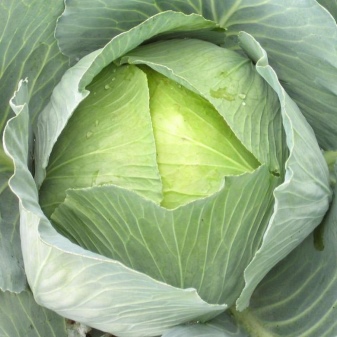
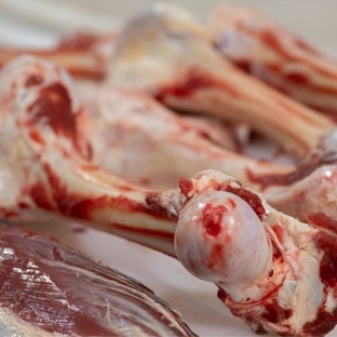
How to accelerate decay?
Having laid a compost pit, you should not wait for a quick result, you need to be patient. The natural process of processing organic matter into fertilizer lasts at least 1.5-2 years. But there is another way: acceleration can be provoked by special means. This method is especially relevant where the warm period does not last long. There are several special tools. Add to compost, for example, "Tamir". With such a preparation, the composting process can be completed within 15-20 days after laying.
It contains a large number of bacteria and microorganisms responsible for the decomposition of organic waste and debris. Such compost will differ in consistency from the usual one, but it will ripen in the soil, which will have a beneficial effect on the plants. Both Tamir and other similar preparations are used according to the same scheme: each layer is sprinkled and poured on top, and if the pile is already formed, a depression is made in the center and powder and liquid are poured there.
It is possible to stimulate the processing of organic matter not only with complex preparations, but also, for example, with yeast. You need to make a solution from 1 liter of water, 200 grams of granulated sugar and 1 tablespoon of dry yeast. Depressions are made in the compost heap and the yeast composition is poured into it. The resulting mushrooms will do their job pretty quickly. Constant moistening with herbal solutions, solutions from chicken manure, as well as ordinary water, periodic tedding of compost with forks - all this also accelerates the process of its maturation. If you add a little of the prepared compost to the fermentation mixture, this also contributes to a faster process of obtaining fertilizer.


Do I need to close for the winter?
Whether it is worth closing the compost pit with a tight lid for the winter is a controversial issue for gardeners, since some believe that if not a lid, then at least cover it with a film, others - that, in general, there is no need to worry about this. In this matter, professional farmers proceed from the fact that the correct laying of the compost during its maturation should give the temperature inside the heap within 70 degrees Celsius, so there is no need to cover it with a film, especially since the heap "will not breathe" in such a shelter.
But if not a film, how to keep this temperature in winter? Agronomists recommend adding ash, lime, phosphates between layers when forming a heap. And in frosts, in order to keep warm, experts advise to cover it with a good layer of soil, and “wrap up” the hole with snow on top.
For information on how to make a compost pit yourself and get good humus, see the next video.













The comment was sent successfully.